A Week in Devonshire
Saturday, June 30 - Chalford - Wells - Totnes
When I went to bed last night there was a
soft English rain falling. Tom came to bed a bit later and the soft rain had
turned into a fairly hard one. This morning is gray and damp, although the
weather forecast is for clearing.
We have breakfast, shower, pack the car and
are on our way before 9:00 a.m. Our route takes us through Bristol over to
Wells.
We are impressed with Wells, the town and the
beautiful cathedral. It is well maintained and has some interesting features,
such as a very old clock – the second oldest operating clock in Europe and a
Chapter House, where the Canons used to conduct daily meetings to discuss the
cathedral business. The cathedral close is wonderful – open and spacious. We
take several photographs of this wonderful building.

 The Chapter House
The Chapter House

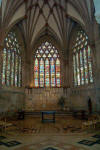 Wells Cathedral
Wells Cathedral
 Couldn't resist this shot of Henderson Place
Couldn't resist this shot of Henderson Place
We drive through Glastonbury, but don’t have
time to stop – pity, as the Abbey there looks interesting.
We head toward the South of England. Our
destination is Crowdy Mill, near Totnes. The drive is reasonably quick, along
an M road.
We are surprised when we drive through Totnes
to see a recently plowed hill near the town. The soil is very red - much like
that on Prince Edward Island. I can understand how my G3 grandfather must have
felt comfortable on PEI having come from an area such as this, although it is
more hilly here than on ‘The Island.”
 Red soil
Red soil
Our cottage, Spillway, is interesting. It is
right next to a brook. It consists of a ‘lounge’, with a loft above for extra
sleeping area (accessed by a ladder), a very small kitchen with a Rayburn stove,
which is also used to heat water, a small loo and a small bedroom. It is nicely
decorated, but I am intimidated by the stove. It doesn’t have dials for
regulating the temperature. “What you see is what you get.” I can’t face
cooking dinner tonight. We go to Totnes to do some shopping (the town has a
legitimate High Street as well as a Safeway) but plan to go out to dinner –
Indian – tonight.
 Spillway cottage
Spillway cottage

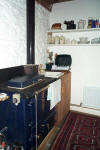
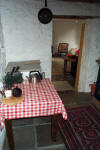 Lounge, Rayburn and dining area
Lounge, Rayburn and dining area
I am surprised at the bustle in Totnes – the
High Street is very busy – we find a greengrocer, a baker, a butcher and a
general store and make some, but not all , of our purchases. We find an
Internet Café and check e-mail - Michelle from the credit union tells us that
Visa has managed to find the problem with our debit card. We head over to
Safeway to complete our shopping and try the cash machine. Glory be - our debit
card works at last!
We return to Spillway and put things away.
We meet the people in the cottage next to us – Debbie and John, son Lucas (age
4) and a daughter, 18 months. They are just in the process of purchasing parts
of Crowdy Mill from the current owners. They want to get the mill up and
operational again, and have B & B and self-catering cottages. We hope that we
are able to talk with them some more before we leave – they used to live in
London, but wanted to own their own home in an area where they could raise their
children. London housing prices were prohibitive.
We drive back to Totnes for dinner at the
Indian restaurant. It is OK, certainly not great, but not bad.
Upon returning to Spillway, I start reading
‘The Country Diary of an Edwardian Lady.” It is beautifully illustrated –
obviously the author knew a great deal about nature.
We have a couple of different alternatives
for tomorrow, haven’t really decided what we are going to do. A lot depends on
mood and weather. However, we are settled into our cottage and don’t have to
move again for a week.
Sunday, July 1 - Totnes - Princetown
Today is gray and we can’t tell if it will be
fine or rainy. We set out to Dartmoor. The road quickly becomes ‘unclassified’
and deteriorates to some of the narrowest we’ve seen yet. Our destination is
Princetown, which has information on Dartmoor. It is also the location of the
infamous Dartmoor prison.
Along the way we see far too much evidence of
foot and mouth disease – many pathways and farms are closed because of the
disease. This has been devastating to the region.
We also see many sheep grazing along the
road. They are unconcerned with the traffic. We stop at a ‘tor’ – we can’t
tell if it is man-made or natural. There are a Dartmoor mare and foal grazing
around the tor. These ponies are rugged little beasts.
 Tor
Tor
We make our way to Princetown. We pick up
bicycling information at the information center and chat with the cashier, who
has a distinctly American accent. She tells us her husband worked here for four
years and then was granted residency status (we wonder if he worked in the
prison – how grim!).
Arthur Conan Doyle stayed in Princetown when
writing ‘The Hound of the Baskervilles.’
We drive on, eventually reaching Plymouth.
Our initial impression isn’t favorable. It is a seedy town. Subsequent reading
causes us to reconsider a visit to the town if we have time.
We’ve read about a couple of pubs in
Ashprington, so we check them out. The village is beautiful! Both pubs look
promising. The road between the two pubs includes one of the steepest grades
we’ve ever seen – 20%. If we had any idea of riding to dinner on Tucats, we
quickly abandon it.
 Too steep for us
Too steep for us
In the afternoon we explore Totnes. There is
quite a bit to see here. The High Street is alive and well, unlike many central
areas in towns in the U.S. We go up to the Norman castle, now a ruin, for
beautiful views over the town.

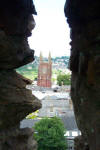
 Totnes
Totnes
In the evening we chat with Debbie and John.
Debbie loves the U.S., John not quite so. We show them pictures of our home
that we have on the computer. We’d like to arrange a house swap. They caution
us strongly against moving here – it is so expensive. They are right – food,
petrol, housing are all very expensive. We decide a house swap for 3-6 months
at a time is better than a permanent move.
Monday, July 2 - Totnes - St Austell - Wadebridge
Today is bright and clear. The weather
forecast is promising a wonderful day today, but thunderstorms tomorrow.
We set off early for “The Eden Project.” We
have no idea what to expect, but Debbie and John next door say it is
interesting.
We pull into the car park for The Eden
Project – still no idea of what we are headed for. We load onto a bus with 60
other people and then offload a short distance further. We trudge ahead on the
pathway and come to a very large pit – at the bottom of the pit are some tents
and two enormous domes with frames of metal, covered in plastic.
 The Eden Project
The Eden Project
The Eden Project is one of the Millenium
projects funded by the National Lottery. Its purpose is to help visitors
understand their relationship to plants. I’m impressed that it isn’t a ‘radical
green’ message. For example, they try to explain sustainable forestry.
One dome is ‘Mediterranean climate’ and must
be the newer habitat for the plants don’t appear to be established. The other
is subtropical. The heat and humidity are intense. So are the crowds. The
admission prices strikes us as expensive, yet the place is packed, even though
today is Monday. Our general impression is that it is too crowded, too
expensive, but interesting.
Next we drive to the Camel Trail. We don’t
know the exact location of the trailhead since it isn’t on our map. We stop at
a pub in Mabyns and have lunch and get directions. A few false turns later we
are at the trailhead.
The trail surface is hard packed gravel for
the most part, though there are stretches of a fine gravel top dressing which
make the going rough because the tires sink into it. The scenery through
farmlands and along the streamside is beautiful. It is quiet and peaceful, the
weather is good, but warm. We pass a point where boys are jumping into the
river from a steep bank – very bucolic.
We peddle to Wadebridge, a nice resort town,
then on to Padstow. We pass heaps of stone that appear to be slate. No wonder
slate is such a common roofing material in this area.
Having reached Padstow, we rest a few minutes
– it is now 5:00 p.m. and we are miles from our cottage. Although this isn’t
the most challenging ride we’ve done, we are tired when we get back to the car,
as well as hungry and gritty.
The trip back to Spillway is uneventful. We
don’t have dinner until 9:30. If we hadn’t been so dusty and dirty we would
have stopped at a pub for dinner, but we weren’t presentable.
Tuesday, July 3 - Totnes - Barnstaple
Today is warm and muggy. We drive from
Totnes to the West Coast of Devon to Barnstaple (pronounced Barn-stble). This
is a lively town. Traffic for the most part is excluded from the downtown
area. There is a street called Butchers’ Row that is lined with shops, mostly
butchers, but some cheese, delicatessens and fish shops. It would be fun to
shop here, but we are a long way from Totnes and don’t want to risk having our
purchases go bad.
We also stop in the Pannier Market. This
appears to be temporary stalls with people selling plants, clothes, shoes,
handicrafts, vegetables, cheese and honey (among other things). We buy some
local strawberries at ₤1 for three punnets. That’s the best price we’ve seen
thus far.
Our plan had been to ride the Tarka Trail but
I’m still tired from yesterday’s ride. We pass on the bike ride, which is a
pity as the trail appears to be one of the better ones.
We drive to Appledore – there is a Maritime
Museum here. This is where William, brother of my G-Grandfather, set up a
shipyard in the 1800’s. Shipping and fishing have been important occupations
here for hundreds of years. The staff at the museum are very helpful in trying
to help us piece together anything about William, but there isn’t much
information. We learn that he is buried in the local church, but it is locked.
I’d like to find out if he had any descendants, but that is rather difficult.
The archivist of the museum might be able to help us, but she is on holiday.
We drive to Bideford – there really isn’t
much to see here, so we decide to head back to Totnes.
We decide to have dinner at one of the pubs
listed in our AAA book, the Durant Arms in Ashprington. It is only two miles
from our cottage, but on unclassified roads. The village is so pretty. The
buildings are almost all gray stone with nice gardens.
The pub is beautifully done, with soft colors
and a traditional bar – no pinball machines or video games here.
I order a veal cutlet in mushroom sauce, Tom
has pork tenderloin in Stilton and mushroom sauce. Both come with roasted
potatoes and nicely cooked fresh vegetables. We pass on starters and dessert,
even though the election looks wonderful. We have an Italian wine – a pino
bianco/chardonnay blend (yes, white wine with meat, why not?)
We take a wrong turn on the way home. The
hedge-rows are so high here that you easily get lost because you can’t see any
landmarks. At times the lanes are so narrow the brush touches both sides of the
car. Some of the trees have grown across the top of the lane to form a green
tunnel. Only the frequent traffic keeps the lanes open.
Wednesday, July 4 - Totnes - Cornwall
It poured last night. This morning the BBC
gives reports of 2” of rain in six hours in the West Country. Power lines are
down and there is fear of flash flooding. Meanwhile, at Wimbledon, it is hot
and muggy, but another fine day. In Scotland it is a good deal cooler. For
such a small island (only 1/3 larger than Washington) the weather is certainly
variable.
We drive to Truro. This city has the newest
Cathedral in Britain, created in 1876 when Cornwall made noise about needing its
own cathedral. The building exterior is more French than any other style. The
interior is Gothic. It is a lively Cathedral – lots of people in and out.
Volunteers give a free guided tour. The windows are beautiful – traditional,
but new compared to so many other cathedrals. There is a beautiful reredos
behind the high altar – made of Bath stone, carved in London and brought in
sections by ship to nearby Falmouth in the late 19th C. Near the parking
lot we see a photo op too good to pass up.
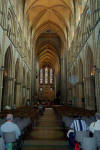

 Truro Cathedral and Toad Hall
Truro Cathedral and Toad Hall
We find if we ask intelligent and respectful
questions people everywhere are eager to answer and will tell you as much as
they can about a place or building or event in history. Our tour guide today,
the fellow in the Barnstaple TI yesterday, and the stewards at St. Michael’s
Mount are all well informed and willing to take the time to explain their piece
of history.
We plan to drive around the far west part of
Cornwall, taking in St. Ives and Lands’ End.
As we drive to St. Ives we see the hydrangeas
are in bloom in great variety of colors – cream, pink, blue, deepest purple.
They are glorious.
St. Ives is another “Britain In Bloom” city
and is beautiful. We’d love to explore it, but after we park the car and head
toward the waterfront, the skies open up in a torrential downpour. We snap a
few photos and head back to the car. It is only four blocks, but our jackets
are soaked through.
We continue our drive along ‘B’ roads to
Lands’ End. This would be a wonderful route if it weren’t so darn wet!
We arrive at Land’s End. It is a tourist
trap of the tackiest type. ₤3 to park, various exhibits, guarantee of all
undercover. We were hoping for wild Cornish seascape and we find concrete and
plastic. We don’t bother stopping.
We proceed to Marazion, the town off which is
located the wonderful former abbey, then fortress, then castle of St. Michael’s
Mount. Since the tide is in, we take a small motor boat to the island. It is
an impressive sight, looming over the bay. The climb up to the structure is
pretty difficult – the stones are rough and uneven, but we wore tennis shoes
today. We arrive at the top – hot and winded – to be treated to a magnificent
view. The parts of the structure that are open to the public are wonderful –
cozy and inviting. Other parts are still inhabited by the St. Aubyn family
(Lord and Lady St.Levan) and are not open to the public. We enjoy the library –
beautiful fireplace, cozy chairs and lots of books in a small intimate room.
The dining room, the former refractory, has a beautiful table – seats about 20 –
and a wonderful ceiling. This is one of those rare, grand houses that you can
imagine living in. “Sherry, please, James.”
 Marazion
Marazion
We return to ‘the mainland’ and stop for a
cream tea. This seems to be a West Country tradition. Scones, strawberry jam
and ‘clotted cream.’ As Tom’s co-worker, Stan, says, “The sound you hear is my
left ventricle slamming shut.” Clotted cream is not as firm as butter, but
thicker than heavy cream. It is lightly sweetened. You put the jam on your
scone, then top with clotted cream and enjoy with a cup of good tea (Earl Gray
is our favorite).
We retrieve our car and head back to Totnes.
We both love Cornwall and would like to spend more time here – particularly if
the weather were more enjoyable.
Thursday, July 5 - Totnes
Today is gray, off and on raining, but warm.
The rain seems to be here for a few days. We want to see the National Motor
Museum in Beaulieu (New Forest Area) and there is a great bike ride in the New
Forest. We decide to make today a ‘work day’ and book a room in New Forest so
we can see the museum at leisure and do the bike ride as well.
Laundry done in Totnes, lunch at our cottage,
we drive toward Kingsbridge as Debbie has told us of the wonderful beaches in
that area. She’s quite right – fine, off-white sand coming off farmland. In
the U.S. such beaches would have McDonald’s and boat rental agencies right next
to them. This is the sort of place we’d love to stay if the weather were
better.
We stop at the TI in Kingsbridge. The BTA
(British Tourist Authority) and others have a wonderful system in the TI's.
Some charge for booking a room ahead – usually a 10% refundable fee – you book,
you give them 10% which is deducted at your lodging. We book a 4 diamond B & B
in Lyndhurst. They call the Lyndhurst TI, get maps, pictures and descriptions
faxed to Kingsbridge, all at no charge to us. Can you imagine that in the U.S.?
Lyndhusrt also has a couple of pubs in the AA
book, so we’ll have a pleasant stay.
We return to Spillway. We’ve exchanged
e-mail and snail mail addresses with Debbie. We’d like to arrange a house swap
a few years from now when her children are a bit older.
We think it would be nice to visit the local
pub for a glass before dinner. As it turns out, this is the worst kind of pub –
video games, smoke and the only white wine is a California ‘Blossom Hill’ of
dubious vintage (Tuesday, 2:00 PM?). We decide to pass on the pleasure and
return to our cottage.
A word about Rayburn stoves. Ours heats
water, heats the cottage and cooks. It is diesel powered. Although there is no
odor, it has a looming presence I find intimidating. Today Debbie showed me her
Aga. I could learn to love an Aga. It has three or four ovens, each
specialized according to what you want to do (bake, roast, keep the new-borne
lamb warm). There is an ample cook top (unlike our Rayburn). I don’t know if
it has a broiler, I didn’t think to ask. I’ve heard that people who have Agas
love them, but they must take a bit of getting used to. They are ‘on’ all the
time. I wonder how costly they are to operate. And they must be hot in the
summer.
Item of interest – today’s newspaper said
there were 31,000 lightening strikes in the West Country yesterday – a once in
three decades storm. People in nearby towns are still without power.
Friday, July 6 - Totnes - Lyndhurst
We manage to pack up and hit the road by 9:30
or so – we have a long drive – not in miles, but in time – to Lyndhurst in the
New Forest. Our objective is the National Motor Museum in Beaulieu (pronounced
Biew-Lee). We’ve heard a lot about it and want to have adequate time to
explore.
The drive is uneventful – even though it
takes – as we have found, typically 25% longer than we’d expected.
New Forest is a National Park, but it has a
few towns and private houses in it. We stay at a nice B & B called Little
Hayes. Our accommodations are quite nice. Again, I am struck by the green
thumbs of the English. The begonias are twice as big as any I’ve ever been able
to grow. The geraniums are a riot of color.
We drive to Beaulieu. On the way we cross
moors – there are numerous ponies on the moor – we learn that they are owned by
various people but allowed to graze to keep the vegetation down. They are too
tame, grazing right next to the road. The speed limit is 40 mph – any faster
and you’d run danger of hitting a pony.
The National Motor Museum is on the grounds
of the Montegue estate. It is one of the best museums we’ve ever seen. The
cars are interesting – beautiful Rolls Royces of a by-gone era of grace and
wealth, a little VW bug from post war Germany, some slick Jaguars. There is a
nearly full size representation of a 1930’s garage.
We spend some time talking to a woman in the
museum who is selling raffle tickets for a Beaulieu Caterham Super 7. Like so
many people here, one or two questions starts a whole conversation. She was an
evacuee during the war – so many 60+ year olds were. What a horrible disruption
to normal family life that must have been. She tells us that on Guernsey they
had 24 hours to evacuate the children – they were sent all over England,
families separated for five long years.

 Caterham Super 7
Caterham Super 7
On the same grounds are the remains of
Beaulieu Abbey, dissolved by Henry VIII. There is a very good exhibition of the
life of the monks.
Finally, we tour Lord and Lady Montegue’s
home (that part that is open to the public). There are many portraits from over
the years, plus several rooms with very fine furnishings. There’s also a
Victorian kitchen of some interest.
 Bell board wired to various rooms
of the house
Bell board wired to various rooms
of the house
On the way out we go through the gift shop.
Lord Montegue has written a book (autobiography) – seems he had some sort of
scandal in the 1950’s – I should buy the book just to find out what the scandal
was all about.
We return to Lyndhurst and walk to the High
Street for dinner. Once again, we choose Indian. This time the meal is
excellent, as is the service.
After dinner we stroll to the nearby pub,
have a glass of wine, then go back to the B & B.